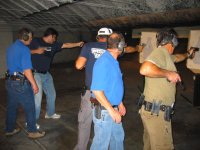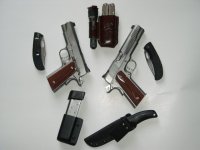Friends,
A few thoughts on BUGs from prior training evolutions:
*Notes from March 04.*
A few observations from last nights workshop.
The focus of the curriculum was support side shooting with both the primary and back up guns with attention given to the diagnostic vs. non diagnostic method to clear primary weapon stoppages.
1. Type one malfunctions: Type ones were set up using snap caps. The shooters didn't know the location of the snap caps in their magazines. Both shooters had the same set up. The format was man on man on paper and steel targets.
Observations: There wasn't any noticeable difference in time between the diagnostic type one clearance vs. transition to back up gun.
2. Emergency reloads. Transition to BUG was significantly faster both in dry practice and during firing drills.
Advantages: The non diagnostic approach (BUG) offers a single solution to multiple stoppages.
1. Primary weapon is inaccessible, fight for the gun.
2. Primary is out of ammunition.
3. Primary is out of your control.
4. Primary has malfunctioned or jammed.
5. Primary has failed mechanically.(broken gun)
Moreover, the mental focus stays on the fight and not on diagnostics. Even if the malfunction can be quickly diagnosed the non diagnostic method doesn't rely on decision making branches, high brass, low brass, no brass etc.
Disadvantages:
1. Climate. Clothing, especially in the work place, may make carrying a back up gun or even a full size primary unpractical.
2. Additional time must be spent for training and skills maintenance. (support side shooting)
3. User comfort. The bigger the bat belt the less likely it will be worn.
Conclusions. At this point in time the end user should decide if the benefit is worth the investment in training time. IMHO the advantages out weigh the disadvantages, but individual life styles and environments may have a greater bearing on the decision to carry addition hardware.
At the conclusion of the workshop the general consensus was that it is a viable option, but may not be for everyone.
*Notes from this past weekends class.*
1. The transition to back up guns was on par with clearing a type one. We took two of the fastest shooters and put them into a relay with several shooters who were running BUGs. We set up type ones and the fast guys ran the drill free style. There really wasn't any noticeable difference in engagement time. Keep in mind that the guys running BUGs had very little to no experience with the transistion to BUG or with support side shooting until this class. Once the skills are dialed in through countless repetition I suspect it may be faster than clearing a type one.
2. The transitioning to BUG in much quicker than the ER and light years ahead of a type three.
3. The transition to BUG addresses a mechanical failure of the primary gun and well as a fight for the primary gun.
4. The transition to BUG addresses the primary gun being hit during the fight.
I realize that most non LEO folks don't carry a BUG, but IMHO once you train in these techniques you just might change your mind. Many who attended this class will be purchasing 5 shot wheel guns or the new Kahr PM series guns.
HTH
Fred Darling www.wct.4t.com
A few thoughts on BUGs from prior training evolutions:
*Notes from March 04.*
A few observations from last nights workshop.
The focus of the curriculum was support side shooting with both the primary and back up guns with attention given to the diagnostic vs. non diagnostic method to clear primary weapon stoppages.
1. Type one malfunctions: Type ones were set up using snap caps. The shooters didn't know the location of the snap caps in their magazines. Both shooters had the same set up. The format was man on man on paper and steel targets.
Observations: There wasn't any noticeable difference in time between the diagnostic type one clearance vs. transition to back up gun.
2. Emergency reloads. Transition to BUG was significantly faster both in dry practice and during firing drills.
Advantages: The non diagnostic approach (BUG) offers a single solution to multiple stoppages.
1. Primary weapon is inaccessible, fight for the gun.
2. Primary is out of ammunition.
3. Primary is out of your control.
4. Primary has malfunctioned or jammed.
5. Primary has failed mechanically.(broken gun)
Moreover, the mental focus stays on the fight and not on diagnostics. Even if the malfunction can be quickly diagnosed the non diagnostic method doesn't rely on decision making branches, high brass, low brass, no brass etc.
Disadvantages:
1. Climate. Clothing, especially in the work place, may make carrying a back up gun or even a full size primary unpractical.
2. Additional time must be spent for training and skills maintenance. (support side shooting)
3. User comfort. The bigger the bat belt the less likely it will be worn.
Conclusions. At this point in time the end user should decide if the benefit is worth the investment in training time. IMHO the advantages out weigh the disadvantages, but individual life styles and environments may have a greater bearing on the decision to carry addition hardware.
At the conclusion of the workshop the general consensus was that it is a viable option, but may not be for everyone.
*Notes from this past weekends class.*
1. The transition to back up guns was on par with clearing a type one. We took two of the fastest shooters and put them into a relay with several shooters who were running BUGs. We set up type ones and the fast guys ran the drill free style. There really wasn't any noticeable difference in engagement time. Keep in mind that the guys running BUGs had very little to no experience with the transistion to BUG or with support side shooting until this class. Once the skills are dialed in through countless repetition I suspect it may be faster than clearing a type one.
2. The transitioning to BUG in much quicker than the ER and light years ahead of a type three.
3. The transition to BUG addresses a mechanical failure of the primary gun and well as a fight for the primary gun.
4. The transition to BUG addresses the primary gun being hit during the fight.
I realize that most non LEO folks don't carry a BUG, but IMHO once you train in these techniques you just might change your mind. Many who attended this class will be purchasing 5 shot wheel guns or the new Kahr PM series guns.
HTH
Fred Darling www.wct.4t.com
Last edited:


